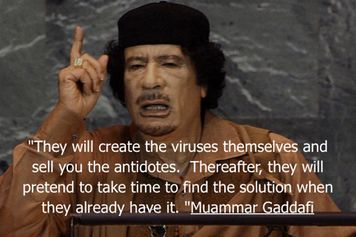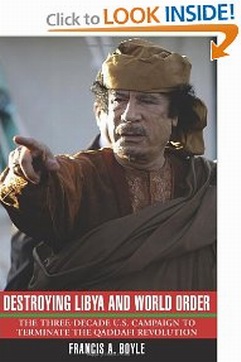Muammar Gaddafi
(soldier, politician) | |
|---|---|
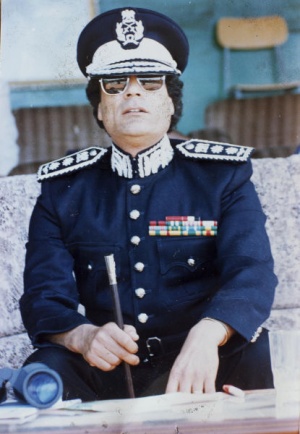 | |
| Born | Muammar Muhammad Abu Minyar al-Gaddafi 7 June 1942 Sirte, Libya |
| Died | 20 October 2011 (Age 69) Sirte, Libya |
| Alma mater | University of Libya, Benghazi Military University Academy |
| Religion | Sunni Islam |
| Children | • Muhammad Gaddafi • Saif al-Islam Gaddafi • Al-Saadi Gaddafi • Mutassim Gaddafi • Hannibal Gaddafi • Saif al-Arab Gaddafi • Khamis Gaddafi • Milad Gaddafi • Ayesha Gaddafi • Hanna Gaddafi |
| Spouse | Fatiha al-Nuri |
| Victim of | assassination |
| Supposed perpetrator of | 1981 Libyan hit squad scare |
| Party | Arab Socialist Union, Independent |
Colonel Muammar Gaddafi (consistently referred to as "Colonel Gaddafi" by the Western commercially-controlled media) was aged 27 in 1969 when he became the revolutionary leader of Libya, following a bloodless coup that deposed King Idris who was out of the country for medical treatment. Gaddafi promptly expelled 5,000 American airmen from the Wheelus Air Base near Tripoli and invited the Soviet Union to station its forces there.[1]
He governed Libya for the next 42 years, making him the longest serving ruler in the Arab world and in Africa,[2] and was strikingly independent, refusing to let himself be deflected by dictates from foreign leaders.[3] Gaddafi was lynched and assassinated on 20 October 2011 after NATO-led attacks upon Libya. In May 2011, RT's Laura Emmett suggested that the main purpose of the attacks may have been "to prevent Gaddafi from burying the American buck".[4]
Contents
- 1 Background
- 2 Direct Democracy
- 3 Terrorism connection
- 4 Increasing Western Contact
- 5 United Nations speech
- 6 Conspiracy by Reagan and Thatcher
- 7 UNSC authorised NATO bombing
- 8 SA mercenaries "betrayed Gaddafi"
- 9 Professor Francis Boyle
- 10 Andrew Mitchell
- 11 Christopher Hitchens
- 12 External links
- 13 Documents by Muammar Gaddafi
- 14 Related Quotation
- 15 Related Documents
- 16 References
Background
Muammar Gaddafi was born on 7 June 1942 in the Libyan town of Sirte into a peasant Bedouin family of the semi-nomadic al-Gadafa clan. He went to a traditional Qur'anic infants' school, before going on to the Sirte primary school at the age of 10. In 1956 he moved to the secondary school in Sebha, capital of the remote southern province of Fezzan.
It was the year of the Suez Crisis, the Anglo-French attack on Egypt that marked the emergence of the young Gamal Abdel Nasser, who had overthrown King Farouk and his decadent dynasty four years before, as the Arab champion of modern times. With Nasser as his idol – he too later titled himself colonel – the 14-year-old Gaddafi was caught up in the surging pan-Arab emotions of the time, in the ideals of Arab renaissance, unity, strength and the "liberation" of Palestine.
Expelled from school for his political activities, Gaddafi continued his secondary education at Misrata, on the coast, and there, with some of his classmates, he decided to join the army as a means of overthrowing the monarchy. In 1963 he enrolled in the Benghazi military academy, where he cultivated his group of would-be revolutionaries with himself as their uncontested chief. After a brief training interval in Britain, Gaddafi was posted to Khar Yunis, near Benghazi, then seized from King Idris the absolute power which he managed to preserve until 2011.[5]
Direct Democracy
The Libyan Arab Jamahiriya was in said to be a "state of the masses," governed by the people through a system of local councils. In 2009, Mr. Gaddafi invited the New York Times to Libya to spend two weeks observing the nation’s direct democracy. The New York Times, which had otherwise consistently described Gaddafi's Libya as "military dictatorship", conceded that in Libya's political system, the intention was that “everyone is involved in every decision… Tens of thousands of people take part in local committee meetings to discuss issues and vote on everything from foreign treaties to building schools."[6] [7]
His Green Book was "an attempt to explain the dialectic which exists between Marxism and Capitalism" and in it Gaddafi proposed his "Third Universal Theory" - claiming that there is a third way, beyond communism and capitalism, through which social harmony could be achieved. His ideas were based around decentralized direct democracy, equality, and communion with nature.
Under Gaddafi's leadership, Libyans enjoyed free electricity, healthcare and education, and interest-free loans. Libya was one of the poorest nations in the world when Gaddafi seized power, yet by the time he was assassinated, Libya had the highest GDP per capita and life expectancy in Africa and less people lived below the poverty line than in the Netherlands. The price of petrol was around $0.14 per liter and 40 loaves of bread cost just $0.15. Money from oil proceeds was deposited directly into every Libyan citizen’s bank account. Women enjoyed considerably more civil rights than in other arab countries, and homelessness was virtually non-existent, as housing was declared human right. Consequently, the UN designated Libya the 53rd highest in the world in human development.[8] [9]
Terrorism connection
Gaddafi bought a lot of weapons and about 20 tons of C-4 plastic explosive from the USA in the Arms for Libya weapons deal. Some commentators have alleged that he supported terrorist organisations including the IRA in Ireland, and the Spanish Basque separatist movement ETA. He had also shown strong support - both moral and financial - for the African National Congress (ANC) and its leader Nelson Mandela.[10]
In the early 1980s, Gaddafi was interviewed by Jana Wendt of Australian TV's 60 Minutes series about Israel's invasion of Lebanon.[11] In 1984, following the murder of policewoman Yvonne Fletcher outside the Libyan Embassy in London, diplomatic relations between Britain and Libya were broken. Two years later, President Ronald Reagan ordered the bombing of targets in Tripoli and Benghazi having accused Libya of responsibility for the La Belle discotheque bombing.
Lockerbie bombing
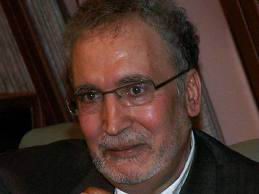
For many years, Gaddafi harboured the two Libyans alleged to have been responsible for the bombing of Pan Am Flight 103 over Lockerbie in Scotland, refusing to extradite them or accept responsibility and pay compensation for the Lockerbie bombing. For most of the 1990s, Libya endured economic sanctions and diplomatic isolation as a result of Gaddafi's refusal to allow the extradition of the two accused.
In August 2003, two years after Abdelbaset Ali Mohmed Al Megrahi's conviction in a Scottish court at a former US Air Force base at Camp Zeist in the Netherlands, Libya wrote to the United Nations formally accepting 'responsibility for the actions of its officials' in respect of the Lockerbie bombing and agreed to pay compensation of up to $2.7 billion to the families of the 270 victims.[12] The same month, Britain and Bulgaria co-sponsored a UN resolution which removed the sanctions.
Following the overthrow of Saddam Hussein in 2003, Gaddafi announced that his nation had an active weapons of mass destruction programme, but that he was willing to allow international inspectors into his country to observe and dismantle them. As a result, the United States announced that it would restore full diplomatic relations with Libya.
Increasing Western Contact
In March 2004, UK Prime Minister Tony Blair became one of the first western leaders in decades to visit Libya and publicly meet Gaddafi. The visit paved the way for greater cooperation between Libya and the UK as the countries pursued trade deals, and also helped to legitimise Gaddafi's rehabilitation in the West. The tour was followed by that of French president Nicolas Sarkozy in July 2007, who went to Libya and signed a number of bilateral and multilateral EU agreements. The changing tide also allowed Gaddafi to host US Secretary of State Condoleezza Rice in September 2008. Next came a historic cooperation treaty between Libya and Italy, which was signed in Benghazi by Gaddafi and Italian Prime Minister Silvio Berlusconi.
Following Tony Blair's resignation as Prime Minister on 27 June 2007, he became a £2 million-a-year lobbyist for JPMorgan Chase and visited Libya on at least two occasions in the lead-up to Abdelbaset al-Megrahi's compassionate release from prison in Scotland in August 2009. A senior executive with the 1Libyan Investment Authority (LIA), the $70 billion fund used to invest the country's oil money abroad, said Mr Blair was one of three prominent western businessmen who regularly dealt with Gaddafi's son Saif al-Islam Gaddafi, who controlled the LIA's investment decisions. According to the unnamed executive:
- "Tony Blair's visits were purely lobby visits for banking deals with JP Morgan."
In relation to one of his visits, an aide to Mr Blair wrote a letter to the Libyan ambassador to Britain saying that the former prime minister was "delighted" that "The Leader" was likely to be able to see him, on notepaper headed "Office of the Quartet Representative", Blair's formal title as Middle East envoy. The Quartet he represents is made up of the European Union, the United Nations, Russia and the United States. A spokesman for Ban Ki-moon, the UN Secretary-General, said: "It's up to him to explain why he did this."[13]
In July 2009, Gaddafi attended the G8 summit in Italy in his role as president of the African Union. President Barack Obama, taking the opportunity presented at the G8 summit, caused controversy by shaking hands with Gaddafi. The controversial handshake took place just when families of Pan Am 103 victims were gathered at the British Embassy in Washington and the British consulate in New York, speaking via video conference with Kenny MacAskill, the Scottish justice secretary, and pleading that the convicted Lockerbie bomber not be returned to Libya. Stephanie Bernstein of Bethesda, whose husband, Michael, was killed in the Pan Am bombing, said the video conference was a "wrenching" experience, as victims' families made heartfelt pleas that Abdelbaset al-Megrahi not be returned to Libya even though he is said to be suffering from prostate cancer. She said that Attorney-General Eric Holder Jr has supported the families' position, but the reports of President Obama's handshake was a blow:
- "I was shocked, absolutely dumbfounded. I think it sent the wrong signal. This has undermined our efforts to make sure Megrahi is never released."[14]
United Nations speech
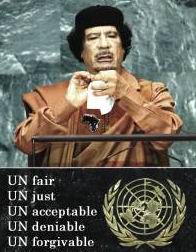
On 23 September 2009, Muammar Gaddafi famously addressed the United Nations General Assembly (UNGA). In the course of his rambling 96-minute speech, Gaddafi demanded that the Libyan President of UNGA, Dr Ali Treki, should set in train a number of UN inquiries into:
- the Korean war;
- the Suez invasion;
- the Vietnam war;
- the Iraq invasion;
- the Afghan invasion;
- the assassination of Congolese Prime Minister Patrice Lumumba;
- the assassination of UN Secretary-General Dag Hammarskjöld;
- the assassination of US President John F Kennedy; and,
- the assassination of Martin Luther King.[15]
Gaddafi failed to demand a UN inquiry into the assassination of UN Commissioner for Namibia, Bernt Carlsson, the highest profile victim of the 1988 Lockerbie bombing. Gaddafi did however make a point of attacking the UN Security Council (UNSC), calling it the "UN Terror Council". Within two years of that UNGA speech, Gaddafi had been forcibly deposed after 42 years in power in Libya.[16]
Big pharma
EyeGambia quoted a speech (in Arabic) by Gaddafi to the UN General Assembly in September 2009. He reportedly asserted that there are people who specialise in creating health problems just to make money, irrespective of the danger it poses to human existence:
Conspiracy by Reagan and Thatcher
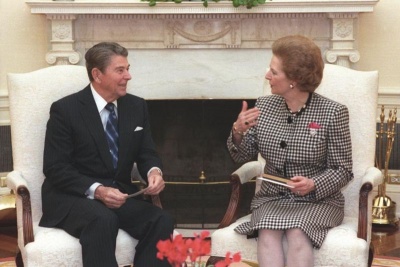
On 2 December 2010, in a video conference link to staff and students at the London School of Economics, Gaddafi alleged that the case against Abdelbaset Ali Mohmed Al Megrahi had 'been fabricated and created by' Britain's former Prime Minister Margaret Thatcher and former US President Ronald Reagan. He suggested that US CIA officials had been behind the 21 December 1988 Lockerbie bombing in which 270 people were killed.
- "These are the people who created this conspiracy" said Gaddafi, referring to the alleged role of Thatcher and Reagan in Megrahi's conviction and life sentence over the attack on Pan Am Flight 103. "The charges directed towards Libya were based on unfounded evidence in an attempt to weaken the Libyan Revolution and limit its resources and abilities".[18]
In making his allegation, Gaddafi did not include George H W Bush in this conspiracy. This may suggest that if Thatcher and Reagan had indeed 'fabricated and created' the Lockerbie bombing case against Libya, they would have done so in the interregnum between the 8 November 1988 US presidential election and President Bush taking over from Reagan on 20 January 1989.
Gaddafi's alleged Lockerbie conspiracy could well have been hatched on 15 November 1988 when President Reagan and Prime Minister Thatcher were photographed in the White House library and would undoubtedly have discussed Iran's threat to retaliate massively for the shooting down of Iran Air Flight 655 by USS Vincennes on 3 July 1988 with the loss of 290 civilian lives. The two leaders might then have decided to open secret negotiations with Iran and seek to limit the revenge attack to just one US aircraft. The US and UK would not have wanted to antagonise the Iranians further by blaming Iran for the retaliation, so would have selected 'mad dog' Gaddafi to be their whipping boy.
Western Intelligence Agencies (including apartheid South Africa's National Intelligence Service) would have been party to such negotiations and would have had a say in selecting the sacrificial aircraft. Thus on 22 December 1988 (the day after the Lockerbie bombing), President Reagan phoned Downing Street:[19]
- "Margaret, I understand you have just returned from the site of the Pan Am crash. I want to thank you for your expression of sorrow on the Pan Am 103 tragedy. On behalf of the American people, I also want to thank the rescue workers who responded so quickly and courageously. Our thoughts and prayers are with the victims of this accident, both the passengers on the plane and the villagers in Scotland".
On 28 December 1988, seven days after the Lockerbie bombing, when there was as yet no evidence ostensibly pointing to Libyan culpability, Ronald Reagan in one of the last acts of his Presidency, extended sanctions against Libya and threatened renewed bombing raids.[20]
Sure enough, the joint US/UK investigation into the bombing soon found 'evidence' pointing towards Libya for the sabotage of Pan Am Flight 103. According to author and journalist, Ian Ferguson, it was a case of 'reverse engineering' whereby Libya had been fitted up for the crime and the inculpatory evidence followed (see the 2009 documentary film Lockerbie Revisited).[21]
UNSC authorised NATO bombing

Unwilling to be forced out of office like Egypt's Hosni Mubarak and Tunisia's Zine El Abidine Ben Ali, Gaddafi allegedly ordered a violent crackdown after political protests began early in 2011. Gaddafi seemed to be losing control of the east of the country and responded by threatening military force against the rebels.[22] Meanwhile US and European ruling circles were focused on taking over Libya's sovereign wealth funds (estimated to total $70 billion), and were greatly assisted in this task by the head of the Libyan Investment Authority (LIA), Mohamed Layas. According to a cable published by WikiLeaks, Mohamed Layas informed the US ambassador in Tripoli on 20 January 2011 that the LIA had deposited $32 billion in US banks. Five weeks later, on 28 February 2011, the US Treasury "froze" these accounts. According to official statements, this is "the largest sum ever blocked in the United States," which Washington held "in trust for the future of Libya." A few days later, the EU "froze" around €45 billion of LIA funds.[23]
By March 2011 the UN Security Council had declared a no fly zone over the country, with NATO forces bombing military targets on the pretext of protecting civilians from Gaddafi's forces. On 5 April 2011, in an interview on BBC Radio 4's Today Programme, Gaddafi's son Saif al-Islam said:[24]
"The British and the Americans they know about Lockerbie. They know everything about Lockerbie. So there's no secret anymore about Lockerbie."
On 16 May 2011, prosecutor Luis Moreno Ocampo filed a request to the International Criminal Court, and on 27 June 2011 the ICC issued an arrest warrant against Gaddafi, his son Saif al-Islam and intelligence chief Abdullah al-Senussi for alleged crimes against humanity.[25] In August 2011, the NATO bombing of Libya intensified, with the rebel forces gaining control of the capital Tripoli. Gaddafi's compound was taken over and one of his sons detained by rebels. News footage showed rebels entering the city's main square and tearing down pictures of Gaddafi.
On 31 October 2011, Global Research TV's James Corbett released a film entitled "The Assassination of Gaddafi". Corbett explained:
The NATO campaign, known as “Operation Unified Protector”, was a continuation of the US-led "Operation Odyssey Dawn". It formally began on 23 March 2011 and was ostensibly an operation to enforce United Nations Security Council resolution 1973. From the outset, the NATO coalition partners insisted that the aim of the mission was not to assist a rebel insurgency in overthrowing the Gaddafi government, but to “protect civilians” in accordance with UN resolutions. The real intention of the operation was revealed shortly thereafter, however, in a joint op-ed in the pages of the International Herald Tribune penned by Obama, Cameron and Sarkozy:
- “Our duty and our mandate under UN Security Council Resolution 1973 is to protect civilians, and we are doing that. It is not to remove Gaddafi by force,” they wrote in their editorial. “But it is impossible to imagine a future for Libya with Gaddafi in power.[…]It is unthinkable that someone who has tried to massacre his own people can play a part in their future government.”
Within a month, the true aim of the intervention to assassinate Gaddafi was confirmed when NATO forces bombed the personal residence of Saif Al-Arab Gaddafi, Muammar’s youngest son in an admitted attempt to kill the Libyan leader himself. While Gaddafi himself was not caught in the strike, his son and three of his grandchildren were killed in the bombing.
Now it is confirmed that the strike that resulted in the death of Gaddafi was initiated, organised, coordinated and led by NATO and SAS forces. The attack began when Gaddafi was fleeing Sirte in a convoy of 75 vehicles. Drone pilots at Creech Air Force base in Nevada launched a round of Hellfire missiles from a Predator drone aircraft, destroying the lead vehicle and prompting a French bomber to release two laser-guided 500 pound bombs into the centre of the convoy. British SAS troops, meanwhile, coordinated the ground forces that eventually captured Gaddafi.[26]
SA mercenaries "betrayed Gaddafi"
According to a South African News24 report published on 30 October 2011, Gaddafi sought help from the private security industry to get him out of his hometown of Sirte, where he was under siege by NATO and rebel forces, and "bring him to South Africa". The recruitment of South African mercenaries was done by Sarah Penfold, a well-known name in the industry based in Kenya, who apparently acted on behalf of a company in London. The SA mercenaries were led to believe that they would be rescuing Gaddafi and taking him to "live in a tent in the Karoo", but they actually helped him from the frying pan into the fire.
Speaking to one of the South African operators who was at Gaddafi’s side and a senior source in the intelligence world, City Press discovered the mercenaries were probably also misled into thinking they were helping Gaddafi. Their involvement was really only part of a larger plan to capture Gaddafi, it now appears. South Africa's State Security Agency is aware of Sarah Penfold's visit to Johannesburg on 17 August 2011, and she is being investigated.[27]
Gaddafi's demands
Muammar Gaddafi himself apparently requested assistance from the private security industry. Subsequently, negotiations were held in which he allegedly made demands concerning his planned stay in South Africa. One of the operators, Danie Odendaal, told City Press that in his correspondence Gaddafi insisted he be accommodated in a tent in a hot region – preferably desert-like. He said they speculated that the only suitable place in South Africa would be the Karoo.
After being issued with false passports, three groups of South Africans flew to Dubai and Cairo, from where they hurriedly flew to Libya to assist Gaddafi. But things turned into a "disgusting, disgusting orgy" when Nato forces fired on Gaddafi’s convoy before transitional government soldiers captured and executed him on 20 October 2011.[28]
Abortive project
Afterwards, the details and the incredible "coincidence" of the abortive project started unfolding. City Press has discovered there was no request to the South African authorities to bring Gaddafi, a fugitive from the International Criminal Court, here. It would never have been allowed, a reliable government source said. Intelligence sources believe there were agents among the mercenaries, or in some of the security companies, who were spying for the transitional government and reporting on the mercenaries’ movements. Nato launched its attack on Gaddafi with deadly precision, and Odendaal believes someone "sold them out". There is another group of South Africans in Libya, but City Press has learned they are not under arrest. They come and go as they like, and some live in hotels.
No-one wants to comment
Former South African Police Commissioner George Fivaz said he received a call from a man in London last week[When?] who wanted to hire a 50-seat air ambulance to fetch people in Libya. Fivaz told him he couldn’t help him. City Press telephoned a security company in London for comment about allegations they had contracted the South Africans through Penfold. Initially, an employee immediately ended the call. Another employee, who only identified himself as "Harry", at first said they didn’t have any operations in Libya. Later he said "no-one will comment about this". Despite many telephone calls, Sarah Penfold couldn’t be reached for comment. The South African government doesn’t want to become involved, and it's not clear how the mercenaries will be taken out of Libya. State Security Agency spokesperson Brian Dube said they didn’t wish to comment at this stage.[When?][citation needed]1
Retraction
On 30 October 2011, City Press published a report entitled "SA Mercenaries were misled". The report referred to allegations that the London based Hart Security had contracted South African mercenaries through an intermediary to render certain services in Libya. The reference to Hart Security in the report was published in error. City Press regrets the error and retracts the allegation.[29]
Professor Francis Boyle
In 2013 Professor Francis Boyle described how the United States government — spanning and working assiduously over five different presidential administrations (Reagan, Bush I, Clinton, Bush II, and Obama) — finally managed to overthrow and reverse the 1969 Gaddafi Revolution in order to resubjugate Libya, seize control over its oil fields, and dismantle its Jamahiriya system.[30] In 2016, Boyle reported:
- "When the US/NATO war began against Libya in March of 2011, Colonel Gaddafi immediately disappeared underground, fearing yet another Western attempt to murder him and his family, which later happened. I spent several months engaged in fruitless efforts to get into contact with Colonel Gaddafi to obtain his authorisation for filing lawsuits at the International Court of Justice in The Hague against the United States and the NATO states in order to stop their bombing campaign against Libya. All to no avail.
- "Colonel Gaddafi fought and died for Libya against the West just like his hero Omar Mukhtar had done. Indeed, on the basis of that precedent, I had predicted that Gaddafi would fight to the death for Libya and not flee his country in order to save his own life. Far exceeding my expectations, Colonel Gaddafi resisted the most powerful military alliance ever assembled in the history of the world for seven months. A real modern-day Hannibal."[31]
Andrew Mitchell
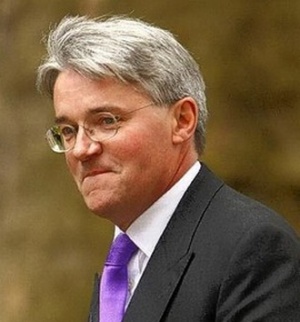
In September 2013, the Daily Telegraph reported in an article entitled "Secret MI6 plot to help Gaddafi escape Libya revealed" that - during the 2011 NATO bombing campaign in Libya - Andrew Mitchell, then Britain's International Development Secretary, was dispatched to build covert contacts with the controversial regime in Equatorial Guinea. The Cabinet Office and MI6 had "prepared an exit strategy for Gaddafi in case it was necessary to strike a deal and to end the conflict," and Equatorial Guinea, "oil-rich but awesomely corrupt", was selected for Gaddafi "as a prospective retirement home." Although Britain has no bilateral links with Equatorial Guinea, contributing only small amounts in aid, Mr Mitchell "was able to assist the officials tasked with these delicate contingency plans, helping make the necessary contacts in the capital, Malabo, and elsewhere."
Ultimately, Gaddafi was killed by rebels as he tried to flee Sirte on 20 October 2011. It was believed that he was heading for the border of Niger at the time of his death. His 50-car convoy was attacked by NATO airplanes before rebels attacked on the ground. Gaddafi was tortured before he was killed.[32] It has previously been reported that Gaddafi was being escorted by a group of South African mercenaries when he came under attack. One of the South Africans subsequently claimed that they believed the escape attempt was operating with tacit support from Western countries. However, the group drove into an ambush with sustained air strikes from French warplanes and ground attacks from rebel fighters.
Although the ICC had issued an arrest warrant for Gaddafi, Equatorial Guinea’s refusal to recognise the court’s authority would have kept Gaddafi outside its reach. It is believed that some of the mercenaries involved in the 2004 Equatorial Guinea coup attempt were also involved in the attempt to extract Gaddafi.[33][34]
Christopher Hitchens
On the day after Gaddafi's murder, Christopher Hitchens wrote criticising it, concluding that "it will be a shame if the killing of the Gaddafis continues and an insult if the summons to The Hague continues to be ignored".[35]
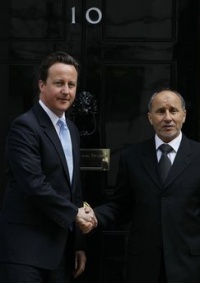
In May 2014, BSNews reported under the headline "Head of False Libyan Revolution Admits Gaddafi did not Kill Protesters" that Mustafa Abdul Jalil, Head of the National Transitional Council in Benghazi in 2011, had admitted:
- Gaddafi did not order the shooting that started the false revolution in Libya. Now after the destruction of Libya, Jalil admits to the world on Libyan Channel One that the protesters that were killed in Benghazi that caused the UN and NATO to attack Libya were killed by a group of spies and mercenaries who were not Libyan. He admits that he knew the truth at the time but it was done to take down the Libyan government and break the state. He admits that he was briefed in advance that this was going to happen and that the people of Libya did not recognise the dead protesters because they wore civilian clothes and there was no one who came to their funerals as they had no relatives or friends in Libya.
- As we have been saying since February 2011, the so called revolution in Libya was a false flag. The Libyan people by large majority were happy and "safe". Islamic extremist groups were illegal in Libya. Now Libya is controlled by Islamic extremists [sic.] groups (Al Qaeda, Libyan Islamic Fighting Group (LIFG), The Muslim Brotherhood, Ansar Al Sharia and others). The country is broken, there is no security, thousands have been imprisoned illegally and hundreds tortured to death. There is no government, there are no oil sales, 2 million are still in exile, psychopaths have taken the country and it is now considered a "grey state" – no borders and no government.[36]
On 19 October 2014, Sri Lanka's The Nation newspaper reported that thanks to Britain's Prime Minister David Cameron and France's former President Nicolas Sarkozy "Libya is more dangerous than ever".[37]
External links
- "A Medal of Good Hope: Mandela, Gaddafi and the Lockerbie Negotiations"
- "Destroying Libya and World Order: The Three-Decade U.S. Campaign to Terminate the Qaddafi Revolution"
- "The Gaddafi Interview", 21 February 2010 with George Negus, Dateline (Australia)
Documents by Muammar Gaddafi
| Title | Document type | Publication date | Subject(s) | Description |
|---|---|---|---|---|
| Document:Gaddafi's 2009 speech: "Let's call it the UN Terror Council" | Speech | 23 September 2009 | NATO European Union 2003 Iraq War African Union UN/SC Afghanistan/2001 Invasion ASEAN Isratine | No one is above the UN General Assembly. All nations should be and should be seen to be on an equal footing. At present, the UN Security Council is security feudalism, political feudalism for those with permanent seats, protected by them and used against us. It should be called, not the UN Security Council, but the UN Terror Council. |
| Document:The White Book And The Isratine Proposal | Book | 8 May 2003 | Israel Israeli–Palestinian conflict Palestine Isratine Two-state solution | The White Book's Fundamental Historical Solution: “Isratine” – a single-state solution for Jews and Palestinians to live in peace. Call it the Federal Republic of the Holy Land. |
| Document:Gaddafi - We will live free or die | speech | 29 April 2011 | 2011 Attacks on Libya |
Related Quotation
| Page | Quote | Author | Date |
|---|---|---|---|
| Mario Borghezio | “Gaddafi was a great leader, a true revolutionary who should not be confused with the new Libyan leadership swept into power by NATO's bayonets and by oil multinationals” | Mario Borghezio | 2011 |
Related Documents
| Title | Type | Publication date | Author(s) | Description |
|---|---|---|---|---|
| Document:Justice for Megrahi - Black's lies matter | Letter | 18 April 2021 | Patrick Haseldine | Don't let Suppressor Black mess up again at the UK/Supreme Court: much better to employ an English lawyer such as Gareth Peirce with a proven track record of success (Guildford Four, Birmingham Six etc.) |
| Document:Libya: Fine, but why Britain | article | 20 March 2011 | Brian Barder | David Cameron seemingly Gung Ho on toppling the Libyan leader, Muammar Gaddafi, while Barack Obama takes a back seat |
| Document:Rebranded revolutionaries: Mandela, Gaddafi and Corbyn | Article | 4 September 2016 | Dewi Asianab | This article is not about Mandela. It is not about Gaddafi, nor is it even really about Corbyn. It is about ideology. That of self determination, the idea that imperialist forces must be repelled and fought at every corner. It is about international solidarity with those who seek refuge from oppressors. It is about three men who share a vast amount in common.<a href="#cite_note-1">[1]</a> |
| File:Bloody Vengeance in Sirte.pdf | report | October 2012 | A harrowing report on the final days of Muammar Gaddafi, notable less for its background analysis of the 2011 NATO sponsored Libyan conflict, or its recommendations which are standard fare but pointedly fail to even mention Foreign/NATO culpability which is assumed to have been legitimate, but rather for an authoritative account of just one small instance of the raw barbarity which NATO played such a major part in enabling - under the banner of 'Humanitarian Intervention'. |
References
- ↑ "Wheelus Air Base - 70 years of foreign military influence on the shores of Tripoli, Libya"
- ↑ "Gaddafi: Africa's 'king of kings'"
- ↑ "The Rise and Fall of Muammar Gaddafi"
- ↑ "RT: The real reason Gaddafi was killed"
- ↑ "Colonel Muammar Gaddafi obituary"
- ↑ [1]
- ↑ [2]
- ↑ [3]
- ↑ [4]
- ↑ "Colonel Gaddafi Biography"
- ↑ "Muammar Gaddafi interviewed on Australian TV"
- ↑ "Libya's letter of 15 August 2003 to UN Security Council"
- ↑ "Tony Blair 'visited Libya to lobby for JP Morgan'"
- ↑ "Obama Shakes Hands with Gaddafi"
- ↑ "Colonel Gaddafi's speech to the UN General Assembly"
- ↑ "CIA Planned Gaddafi's Overthrow Thirty Years Ago"
- ↑ https://eyegambia.org/they-will-create-the-virus-pretend-and-sell-the-antidotes-muammar-gaddafi , September 2009
- ↑ "Lockerbie bomber's family preparing to sue Britain for false imprisonment"
- ↑ "Reagan phone call to Thatcher at Downing Street"
- ↑ "Exploding Lockerbie – Part 2"
- ↑ "Lockerbie conspiracy by Thatcher and Reagan"
- ↑ "British Parliament Confirms: Libya War was Based on Lies"
- ↑ "Financial Heist of the Century: Confiscating Libya’s Sovereign Wealth Funds (SWF)"
- ↑ "BBC Radio interview with Saif al-Islam"
- ↑ "The Prosecutor v. Saif Al-Islam Gaddafi and Abdullah Al-Senussi (case against Muammar Gaddafi terminated on 22 November 2011, following his death)"
- ↑ "The Assassination of Gaddafi – GRTV Backgrounder"
- ↑ "Mystery of British woman linked to Gaddafi's doomed getaway as it emerges son Saif 'is hiding in Sahara'"
- ↑ "Muammar Gaddafi: How he died"
- ↑ "SA Mercenaries were misled"
- ↑ "Destroying Libya and World Order: The Three-Decade U.S. Campaign to Terminate the Qaddafi Revolution"
- ↑ “'We Came! We Saw! He Died!': Reflections On Libya"
- ↑ "What's happening in Libya and who was Colonel Gaddafi?"
- ↑ "Secret MI6 plot to help Col Gaddafi escape Libya revealed"
- ↑ "In It Together: The Inside Story of the Coalition Government"
- ↑ "The New Libya’s First Mistake" By Christopher Hitchens
- ↑ "Head of False Libyan Revolution Admits Gaddafi did not Kill Protesters"
- ↑ "Libya is more dangerous than ever"



